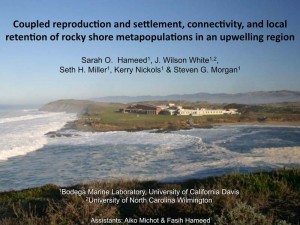 Sarah Hameed presented the results of her larval dispersal model for the flat porcelain crab (Petrolisthes cinctipes) at the Larval Biology Symposium held in Berkeley, CA in July. With the help of volunteers and lab technicians, Sarah Hameed conducts regular field surveys of flat porcelain crab (Petrolisthes cinctipes) populations to assess the role of fecundity in driving population dynamics.
Sarah Hameed presented the results of her larval dispersal model for the flat porcelain crab (Petrolisthes cinctipes) at the Larval Biology Symposium held in Berkeley, CA in July. With the help of volunteers and lab technicians, Sarah Hameed conducts regular field surveys of flat porcelain crab (Petrolisthes cinctipes) populations to assess the role of fecundity in driving population dynamics.
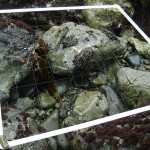
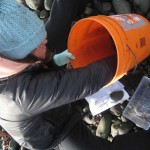
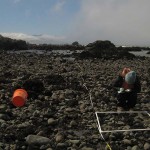 Lisa Komoroske completed thermal and salinity trials on delta smelt, and worked on finishing the environmental transcriptomes for green, loggerhead, and leatherback turtles. The thermal and salinity trials are to understand the impact of climate change on the delta smelt, an important base of the SF Bay-Delta ecosystem. She will be using these data to understand lethal and sublethal stressor tolerances, and then use the data in climate change projection models to understand how smelt habitat use will change under different climate change scenarios for the next 50-100 yrs.
Lisa Komoroske completed thermal and salinity trials on delta smelt, and worked on finishing the environmental transcriptomes for green, loggerhead, and leatherback turtles. The thermal and salinity trials are to understand the impact of climate change on the delta smelt, an important base of the SF Bay-Delta ecosystem. She will be using these data to understand lethal and sublethal stressor tolerances, and then use the data in climate change projection models to understand how smelt habitat use will change under different climate change scenarios for the next 50-100 yrs.
This summer, Olivia Rhoades set up the major preliminary experiments to better understand red abalone behavior and its ecological impacts on other species. She wants to understand abalone movement, feeding, and impact on other kelp forest species, particularly on kelp and other algae. This work will help maintain a sustainable red abalone fishery.
This summer, Patrick Grof-Tisza and his undergraduate student assistant Keenan conducted many surveys and manipulative experiments. They quantified larval and pupal predation by invertebrate and vertebrate predators and assessed the role of microhabitat mediating this predation. A portion of this work on “Non-trophic Effects of Litter Reduce Ant Predation and Determine Caterpillar Survival and Distribution” has already been submitted to the ecology journal Oikos.
Patrick Grof-Tisza and his undergraduate student assistant Keenan employed Capture-Mark-Recapture methods to estimate the population size of our focal species, the ranchman's tiger moth (P. virginalis) and to determine dispersal ability. This proved to be more difficult than anticipated, as the moth population seemed to have crashed this season even though it was one of the largest larval years on record!
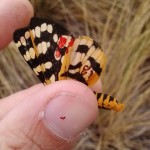
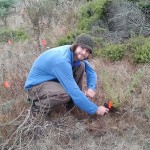
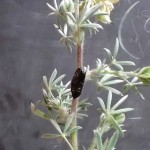 During summer, 2012, Sean Riddle did a short collaboration with IBM at their Almaden Research Center in San Jose. He helped them work on an exciting project merging many predictive models to get more complex predictions that can help with things like city planning. He was also a co-author on an overview paper about scientific workflows and provenance titled “Scientific Workflows and Provenance: Introduction and Research Opportunities” in the journal Datenbank- Spektrum. He is currently in the early stages of work of a paper about comparative provenance.
During summer, 2012, Sean Riddle did a short collaboration with IBM at their Almaden Research Center in San Jose. He helped them work on an exciting project merging many predictive models to get more complex predictions that can help with things like city planning. He was also a co-author on an overview paper about scientific workflows and provenance titled “Scientific Workflows and Provenance: Introduction and Research Opportunities” in the journal Datenbank- Spektrum. He is currently in the early stages of work of a paper about comparative provenance.
This summer, Anna Steel went to the national conference for the American Fisheries Society, in Minneapolis/St. Paul MN. It was a fantastic experience - she presented a talk and a poster, took a continuing education course in Advanced ArcGIS, met lots of wonderful and inspiring people, and ate Asian Carp (an invasive species that turns out to be delicious if cooked right!)
In the spring and summer of 2012, Chris Griesemer conducted fieldwork, driving up and down the northern California coast looking for tiny new crabs. His goal was to catch these little guys as they returned from developing in the plankton, a nutritive and sometimes dangerous nursery for the larvae of so many of the shore invertebrates we know and love.
Chris Griesemer attended the Larval Biology conference in August 2012, hosted by Bodega Marine Laboratory faculty and students in Berkeley. 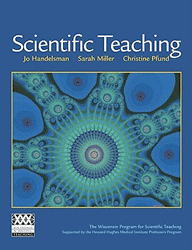
Renate Eberl and Jessica Bean attended a National Academies Summer Institute on Undergraduate Education National Academies Summer Institute on Undergraduate Education at the Evergreen State College, Washington about scientific teaching methods.
During fall 2012, CAMEOS seminar participants are reading, discussing, and implementing methods from the text Scientific Teaching by Jo Handelsman et al.
